Effects of Climate Events on the Trophic Status of an Amazonian Estuary
Abstract
1. Introduction
2. Study Area
3. Data and Methods
3.1. Methodology for Assessing Climate and Hydrological Conditions
3.2. Methodology for Determining Physical and Chemical Indicators of Water Quality
3.3. Methodology of Statistical Data Processing
4. Results
4.1. Climatological Aspects
4.1.1. Typical Conditions
4.1.2. Atypical Conditions
El Niño Event: Dry Season (2006) and Rainy Season (2007)
La Niña Event: Dry Season (2010) Rainy Season (2011)
Drought Event: Dry Season (2010) and Rainy and Dry Seasons (2013)
4.2. Hydrological Aspects
5. Discussion
5.1. Climatological Conditions
5.2. Effects of Climate Events on Hydrological Aspects
6. Conclusions
7. Further Research Questions
Author Contributions
Funding
Data Availability Statement
Acknowledgments
Conflicts of Interest
References
- Kennish, M.J. Environmental threats and environmental future of estuaries. Environ. Conserv. 2002, 29, 78–107. [Google Scholar] [CrossRef]
- Whittaker, R.H.; Likens, G.E. The biosphere and man. In Primary Productivity of the Biosphere; Lieth, H., Whittaker, R.H., Eds.; Springer: New York, NY, USA, 1975; pp. 305–328. [Google Scholar]
- McLusky, D.S.; Elliott, M. The Estuarine Ecosystem: Ecology, Threats and Management; Oxford University Press: New York, NY, USA, 2004. [Google Scholar] [CrossRef]
- Elliott, M.; Quintino, V. The Estuarine Quality Paradox, Environmental Homeostasis and the difficulty of detecting anthropogenic stress in naturally stressed areas. Mar. Pollut. Bull. 2007, 54, 640–645. [Google Scholar] [CrossRef] [PubMed]
- García-Rodríguez, F.; Brugnoli, E.; Muniz, P.; Venturini, N.; Burone, L.; Hutton, M.; Rodriguez, M.; Pita, A.; Kandratavicius, N.; Perez, L.; et al. Warm-phase ENSO events modulate the continental freshwater input and the trophic state of sediments in a large South American estuary. Mar. Freshw. Res. 2013, 65, 1. [Google Scholar] [CrossRef]
- Pereira, L.C.C.; Costa, A.K.R.; Costa, R.M.; Magalhães, A.; Flores-Montes, M.J.; Jiménez, J.A. Influence of a drought event on hydrological characteristics of a small estuary on the amazon mangrove coast. Estuaries Coasts 2017, 41, 676–689. [Google Scholar] [CrossRef]
- Woodward, G.; Bonada, N.; Brown, L.E.; Death, R.G.; Durance, I.; Gray, C.; Hladyz, S.; Ledger, M.E.; Milner, A.M.; Ormerod, S.J.; et al. The effects of climatic fluctuations and extreme events on running water ecosystems. Philos. Trans. R. Soc. 2016, 371, 20150274. [Google Scholar] [CrossRef]
- Wetz, M.S.; Yoskowitz, D.W. An ‘extreme’ future for estuaries? Effects of extreme climatic events on estuarine water quality and ecology. Mar. Pollut. Bull. 2013, 69, 7–18. [Google Scholar] [CrossRef]
- Thompson, P.A.; O’Brien, T.D.; Paerl, H.W.; Peierls, B.L.; Harrison, P.J.; Robb, M. Precipitation as a driver of phytoplankton ecology in coastal Waters: A climatic perspective. Estuar. Coast. Shelf Sci. 2015, 162, 119–129. [Google Scholar] [CrossRef]
- Costa, A.K.R.; Pereira, L.C.C.; Jiménez, J.A.; Oliveira, A.R.G.; Flores-Montes, M.J.; Costa, R.M. Effects of Extreme Climatic Events on the Hydrological Parameters of the Estuarine Waters of the Amazon Coast. Estuaries Coasts 2022, 45, 1517–1533. [Google Scholar] [CrossRef]
- Oliveira, A.R.G.; Queiroz, J.B.M.; Pardal, E.C.; Pereira, L.C.C.; Costa, R.M. How does the phytoplankton community respond to the effects of La Niña and post-drought events in a tide-dominated Amazon estuary? Aquat. Sci. 2023, 85, 9. [Google Scholar] [CrossRef]
- Procópio, A.D.; Costa, R.M.; Magalhães, A.; Silva, D.C.; Silva, T.R.C.; Fernandes, F.S.; Pereira, L.C.C. Effects of the El Niño 2015/2016 event on Acartia tonsa and A. lilljeborgii (Copepoda) production in a Brazilian Amazon estuary. Ecohydrol. Hydrobiol. 2024, in press. [Google Scholar] [CrossRef]
- Pereira, L.C.C.; Oliveira, S.M.O.; Costa, R.M.; Costa, K.G.; Vila-Concejo, A. What happens on na equatorial beach on the Amazon coast when La Niña occurs during the rainy season? Estuar. Coast. Shelf Sci. 2013, 135, 116–127. [Google Scholar] [CrossRef]
- Andrade, M.P.; Magalhães, A.; Pereira, L.C.C.; Flores-Montes, M.J.; Pardal, E.C.; Andrade, T.P.; Costa, R.M. Effects of a La Niña evento n hydrological patterns and copepod community structure in a shallow tropical estuary (Taperaçu, Northern Brazil). J. Mar. Syst. 2016, 164, 128–143. [Google Scholar] [CrossRef]
- Figueroa, S.N.; Nobre, C. Precipitation distribution over Central and Western Tropical South America. Climanálise 1990, 5, 36–45. [Google Scholar]
- Fernandes, K.; Baethgen, W.; Bernardes, S.; DeFries, R.; DeWitt, D.G.; Goddard, L.; Lavado, W.; Lee, D.E.; Padoch, C.; Pinedo-Vasquez, M.; et al. North Tropical Atlantic influence on western Amazon fire season variability. Geophys. Res. Lett. 2011, 38, L12701. [Google Scholar] [CrossRef]
- García-García, D.; Ummenhofer, C.C. Multidecadal variability of the continental precipitation annual amplitude driven by AMO and ENSO. Geophys. Res. Lett. 2015, 42, 526–535. [Google Scholar] [CrossRef]
- Marengo, J.A.; Nobre, C.A.; Oyama, T.M.; Sampaio, G.; Camargo, H.; Alves, L.; Oliveira, R. The Drought of Amazonia in 2005. J. Clim. 2008, 21, 495–516. [Google Scholar] [CrossRef]
- Zeng, N.; Yoon, J.; Marengo, J.A.; Subramanian, A.; Nobre, C.A.; Mariotti, A.; Neelin, J.D. Causes and impacts of the 2005 Amazon drought. Environ. Res. Lett. 2008, 3, 014002. [Google Scholar] [CrossRef]
- Yoon, J.H.; Zeng, N. An Atlantic influence on Amazon rainfall. Clim. Dyn. 2010, 34, 249–264. [Google Scholar] [CrossRef]
- Coelho, C.A.S.; Cavalcanti, I.A.F.; Costa, S.M.S.; Freitas, S.R.; Ito, E.R.; Luz, G.; Santos, A.F.; Nobre, C.A.; Marengo, J.A.; Pezza, A.B. Climate diagnostics of three major drought events in the Amazon and illustrations of their seasonal precipitation predictions. Meteorol. Appl. 2012, 19, 237–255. [Google Scholar] [CrossRef]
- Trenberth, K.E.; Dai, A.; Van Der Schrier, G.; Jones, P.D.; Barichivich, J.; Briffa, K.R.; Sheffield, J. Global warming and changes in drought. Nat. Clim. Chang. 2014, 4, 17–22. [Google Scholar] [CrossRef]
- Marengo, J.A.; Tomasella, J.; Alves, L.M.; Soares, W.R.; Rodriguez, D.A. The drought of 2010 in the Amazon region. Geophys. Res. Lett. 2011, 38, L12703. [Google Scholar]
- Espinoza, J.C.; Ronchail, J.; Guyot, J.L.; Junquas, C.; Drapeau, G.; Martinez, J.M.; Santini, W.; Vauchel, P.; Lavado, W.; Ordoñez, J.; et al. From drought to flooding: Understanding the abrupt 2010–11 hydrological anual cycle in the Amazonas River and tributaries. Environ. Res. Lett. 2012, 7, 024008. [Google Scholar] [CrossRef]
- Marengo, J.A.; Borma, L.S.; Rodriguez, D.A.; Pinho, P.; Soares, W.R.; Alves, L.M. Recent extremes of drought and flooding in Amazonia: Vulnerabilities and human adaptation. Am. J. Clim. Chang. 2013, 2, 87–96. [Google Scholar] [CrossRef]
- Williams, E.; Dall’ Antonia, A.; Dall’ Antonia, V.; Almeida, J.M.; Suarez, F.; Liebmann, B.; Malhado, C.M. The drought of the century in the Amazon Basin: An analysis of the regional variation of rainfall in South America in 1926. Acta Amaz. 2005, 35, 231–238. [Google Scholar] [CrossRef]
- Xu, L.; Samantha, A.; Costa, M.H.; Ganguly, S.; Nemani, R.R.; Myneni, R.B. Widespread decline in greenness of Amazonian vegetation due to the 2010 drought. Geophys. Res. Lett. 2011, 38, L07402. [Google Scholar] [CrossRef]
- Pinho, P.F.; Orlove, B.; Lubell, M. Overcoming barriers to collective action in community-based fisheries management in the Amazon. Hum. Organ. 2012, 71, 99–109. [Google Scholar] [CrossRef]
- Seneviratne, S.I.; Nicholls, N.; Easterling, D.; Goodess, C.M.; Kanae, S.; Kossin, J.; Luo, Y.; Marengo, J.; Mcinnes, K.; Rahimi, M.; et al. Changes in climate extremes and their impacts on the natural physical environment. In Managing the Risks of Extreme Events and Disasters to Advance Climate Change Adaptation; Field, C.B., Barros, V., Stocker, T.F., Qin, D., Dokken, D.J., Ebi, K.L., Mastrandrea, M.D., Mach, K.J., Plattner, G.K., Allen, S.K., et al., Eds.; Cambridge University Press: Cambridge, UK, 2012; pp. 109–230. [Google Scholar]
- Tomasella, J.; Pinho, P.F.; Borma, L.S.; Marengo, J.A.; Nobre, C.A.; Bittencourt, O.R.F.O.; Prado, M.C.R.; Rodriguez, D.A.; Cuartas, L.A. The droughts of 1997 and 2005 in Amazonia: Floodplain hydrology and its potential ecological and human impacts. Clim. Chang. 2013, 116, 723–746. [Google Scholar] [CrossRef]
- Marengo, J.A.; Alves, L.M.; Wagner, R.S.; Rodriguez, D.A. Two Contrasting Severe Seasonal Extremes in Tropical South America in 2012: Flood in Amazonia and Drought in Northeast Brazil. Am. Meteorol. Soc. 2013, 26, 9137–9154. [Google Scholar] [CrossRef]
- Dittmar, T.; Lara, R.J. Driving forces behind nutrient and organic matter dynamics in a mangrove tidal creek in North Brazil.Estuarine. Coast. Shelf Sci. 2001, 52, 249–259. [Google Scholar] [CrossRef]
- Monteiro, M.C.; Jiménez, J.A.; Pereira, L.C.C. Natural and human controls of water quality of na Amazon estuary (Caeté-PA, Brazil). Ocean Coast. Manag. 2016, 124, 42–52. [Google Scholar] [CrossRef]
- Wolf, M.; Koch, V.; Isaac, V. A Trophic flow model of the Caeté mangrove estuary (North Brazil) with considerations for the sustainable use of its resources. Estuar. Coast. Shelf Sci. 2000, 50, 789–803. [Google Scholar] [CrossRef]
- Krause, G.; Schories, D.; Glaser, M.; Diele, K. Spatial Patterns of Mangrove Ecosystems: The Bragantinian Mangroves of Northern Brazil (Bragança, Pará). Ecotropica 2001, 7, 93–107. [Google Scholar]
- Lara, R.J.; Dittmar, T. Nutrient dynamics in a mangrove creek (North Brazil) during the dry season. Mangroves Salt Marshes 1999, 3, 185–195. [Google Scholar] [CrossRef]
- Monteiro, M.C.; Pereira, L.C.C.; Jiménez, J.A. The trophic status of an amazonian estuary under anthropogenic pressure (Brazil). J. Coast. Res. SI 2016, 75, 98–102. [Google Scholar] [CrossRef]
- IBGE—Instituto Brasileiro de Geografia e Estatística. Estimativas da População de. 2015. Available online: http://www.ibge.gov.br/home/estatistica/populacao/estimativa2015 (accessed on 16 March 2016).
- Guimarães, D.O.; Pereira, L.C.C.; Costa, R.M. Aspectos Socioeconômicos e Ambientais das Comunidades Rurais da Bacia Hidrográfica do Rio Caeté (Pará-Brasil). Gerenciamento Costeiro Integr. 2009, 9, 71–84. [Google Scholar] [CrossRef]
- Pereira, L.C.C.; Monteiro, M.C.; Guimarães, D.O.; Costa, R.M. Seasonal effects of wastewater to the water quality of the Caeté river estuary. An. Acad. Bras. Ciênc. 2010, 82, 467–478. [Google Scholar] [CrossRef]
- Sousa, N.S.S.; Monteiro, M.C.; Gorayeb, A.; Costa, R.; Pereira, L.C.C. Effects of sewage on natural enrironments of the amazona region (Pará-Brazil). J. Coast. Res. SI 2016, 75, 158–162. [Google Scholar] [CrossRef]
- NOAA—National Oceanic and Atmospheric Administration. Climate Prediction Center. 2018. Available online: www.cpc.ncep.noaa.gov/products/precip/CWlink/MJO/enso.shtml (accessed on 20 May 2018).
- Marengo, J.A.; Espinoza, J.C. Extreme seasonal droughts and floods in Amazonia: Causes, trends and impacts. Int. J. Climatol. 2015, 36, 1033–1050. [Google Scholar] [CrossRef]
- Parsons, T.R.; Strickland, J.D.H. Discusson of spectrophometric determination of marine-plant pigments, with revised equations for ascertaining chlorophyll a and carotenois. J. Mar. Res. 1963, 21, 105–156. [Google Scholar]
- UNESCO—United Nations Educational, Scientific and Cultural Organization. Determination of Photosynthetic Pigments in Sea-Water; UNESCO: Paris, France, 1966. [Google Scholar]
- Strickland, J.D.H.; Parsons, T.R.A. A Practical Handbook of Seawater Analysis; Bulletin 167; Alger Press: Ottawa, ON, Canada, 1972. [Google Scholar]
- Grasshoff, K.; Emrhardt, M.; Kremling, K. Methods of Seawater Analysis; Verlag Chemie: New York, NY, USA, 1983. [Google Scholar]
- Vollenweider, R.A.; Giovanardi, F.; Rinaldi, A. Characterization of the trophic conditions of marine coastal waters with special reference to the NW Adriatic Sea: Proposal for a trophic scale, turbidity and generalized water quality index. Environmetrics 1998, 9, 329–357. [Google Scholar] [CrossRef]
- Conover, W.O.J. Pratical Nonparametric Statistics; Jonh Wiley: New York, NY, USA, 1971. [Google Scholar]
- Sokal, R.R.; Rohlf, F.J. Biometry: The Principles and Pratice of Numerical Classification in Biological Research; W.H. Freeman: San Francisco, CA, USA, 1969. [Google Scholar]
- CPTEC/INMET. Climatologia de Precipitação (mm) 2018; CPTEC/INMET: PARÁ, Brazil, 2018. [Google Scholar]
- Gloor, M.; Brienen, R.J.W.; Galbraith, D.; Feldpausch, T.R.; Schöngart, J.; Guyot, J.L.; Espinoza, J.C.; Lloyd, J.; Phillips, O.L. Intensification of the Amazon hydrological cycle over the last two decades. Geophys. Res. Lett. 2013, 40, 1729–1733. [Google Scholar] [CrossRef]
- Espinoza, J.C.; Lengaigne, M.; Ronchail, J.; Janicot, S. Large-scale circulation patterns and related rainfall in the Amazon Basin: A neuronal networks approach. Clim. Dyn. 2012, 38, 121–140. [Google Scholar] [CrossRef]
- INMET (Instituto Nacional de Meteorologia). 2018. Available online: http://www.inmet.gov.br/portal/index.php?r=estacoes/estacoesconvencionais (accessed on 14 April 2020).
- Lund-Hansen, L.C.; Thorbjørn, K.T.; Andersen, J.; Nielsen, M.H.; Doan-Nhu, H.; Nguyen-Ngoc, L. Impacts and effects of a historical high and ENSO linked freshwater inflow in the tropical estuary Nha Phu, southeast Vietnam. Reg. Stud. Mar. Sci. 2018, 17, 28–37. [Google Scholar] [CrossRef]
- Costa, A.K.R.; Pereira, L.C.C.; da Costa, R.M.; Monteiro, M.C.; Flores-Montes, M.J. Oceanographic processes in an Amazon estuary during an atypical wet season. J. Coast. Res. SI 2013, 65, 1104–1109. [Google Scholar] [CrossRef]
- Monteiro, M.C.; Pereira, L.C.C.; Guimarães, D.O.; Costa, R.M.; Souza-Filho, P.W.M.; Vieira, S.R.; Jiménez, J.A. Influence of natural and anthropogenic conditions on the water quality of the Caeté River Estuary (NE Brazil). J. Coast. Res. SI 2011, 64, 1535–1539. [Google Scholar]
- Cohen, M.C.L.; Lara, R.J. Temporal changes of mangrove vegetation boundaries in Amazonia: Application of GIS and remote sensing techniques. Wetl. Ecol. Manag. 2003, 11, 223–231. [Google Scholar] [CrossRef]
- Magalhães, A.; Costa, R.M.; Liang, T.H.; Pereira, L.C.C.; Ribeiro, M.J.S. Spatial and temporal distribution in density and biomass of two Pseudodiaptomus species (Copepoda: Calanoida) in the Caeté River Estuary (Amazon region-North of Brazil). Braz. J. Biol. 2006, 66, 421–430. [Google Scholar] [CrossRef]
- Pereira, L.C.C.; Jiménez, J.A.; Pineda, M.G.; Costa, A.K.R.; Sousa, N.S.S.; Oliveira, A.R.G.; Costa, R.M. Assessment of trophic status in Amazonian estuaries: A reinterpretation of TRIX values in mangrove estuaries. Ocean Coast. Manag. 2023, 244, 106805. [Google Scholar] [CrossRef]
- Pereira, L.C.C.; Sousa, N.S.S.; Rodrigues, L.M.S.; Monteiro, M.C.; Silva, S.R.S.; Oliveira, A.R.G.; Dias, A.B.B.; Costa, R.M. Effects of the lack of basic public sanitation on the water quality of the Caeté River estuary in northern Brazil. Ecohydrol. Hydrobiol. 2021, 21, 299–314. [Google Scholar] [CrossRef]
- Matos, J.B.; Sodré, D.K.L.; Costa, K.G.; Pereira, L.C.C.; Costa, R.M. Spatial and temporal variation in the composition and biomass of phytoplankton in an Amazonian estuary. J. Coast. Res. SI 2011, 64, 1525–1529. [Google Scholar]
- Hildebrand, M. Diatoms, Biomineralization Processes, and Genomics. Chem. Rev. 2008, 108, 4855–4874. [Google Scholar] [CrossRef] [PubMed]
- Sathicq, M.B.; Bauer, D.E.; Gómez, N. Influence of El Niño Southern Oscillation phenomenon on coastal phytoplankton in a mixohaline ecosystem on the southeastern of South America: Río de la Plata estuary. Mar. Pollut. Bull. 2015, 98, 26–33. [Google Scholar] [CrossRef] [PubMed]
- Zhang, Z.; Craft, C.B.; Xue, Z.; Tong, S.; Lu, X. Regulating effects of climate, net primary productivity, and nitrogen on carbon sequestration rates in temperate wetlands, Northeast China. Ecol. Indic. 2016, 70, 114–124. [Google Scholar] [CrossRef]
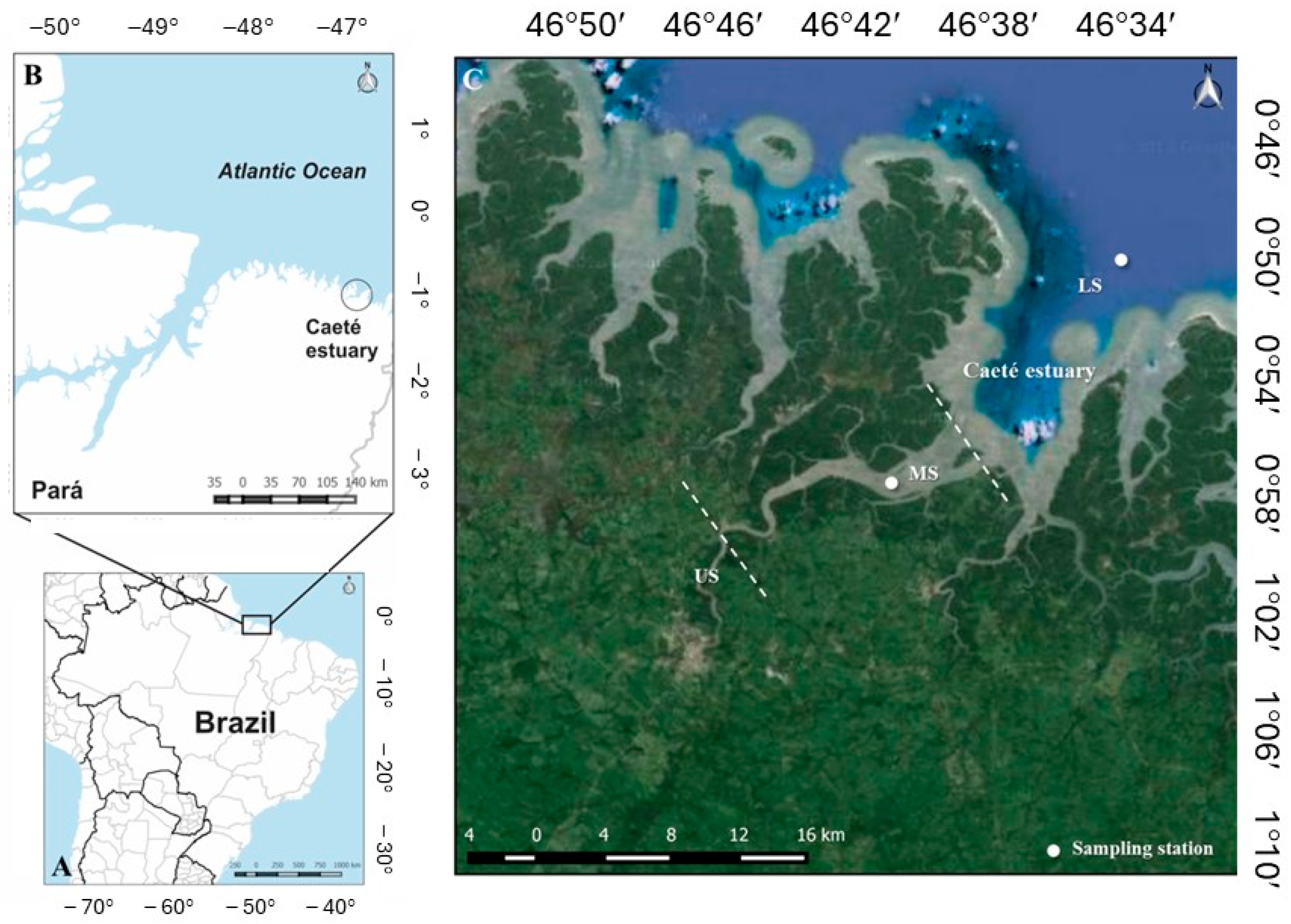

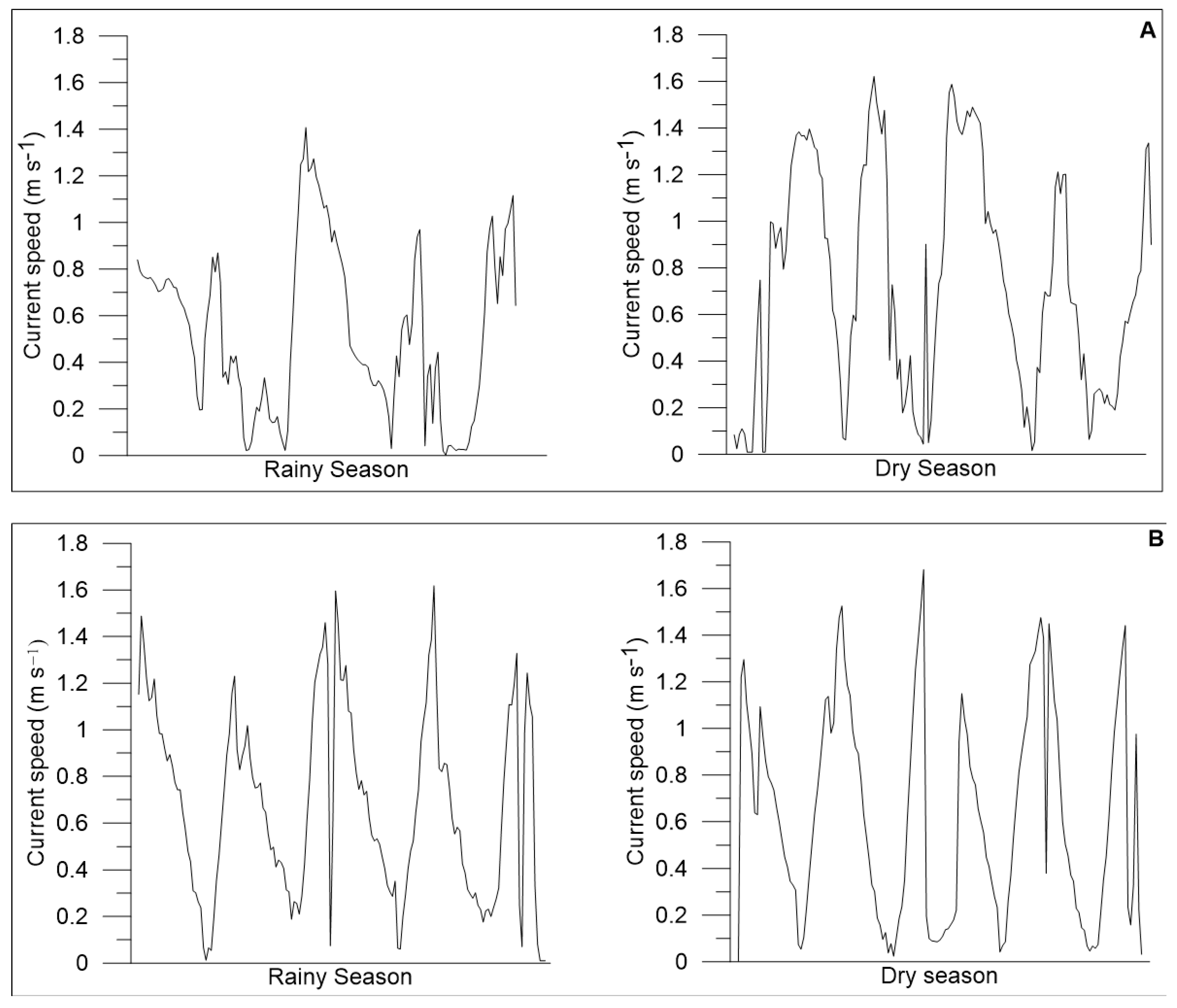
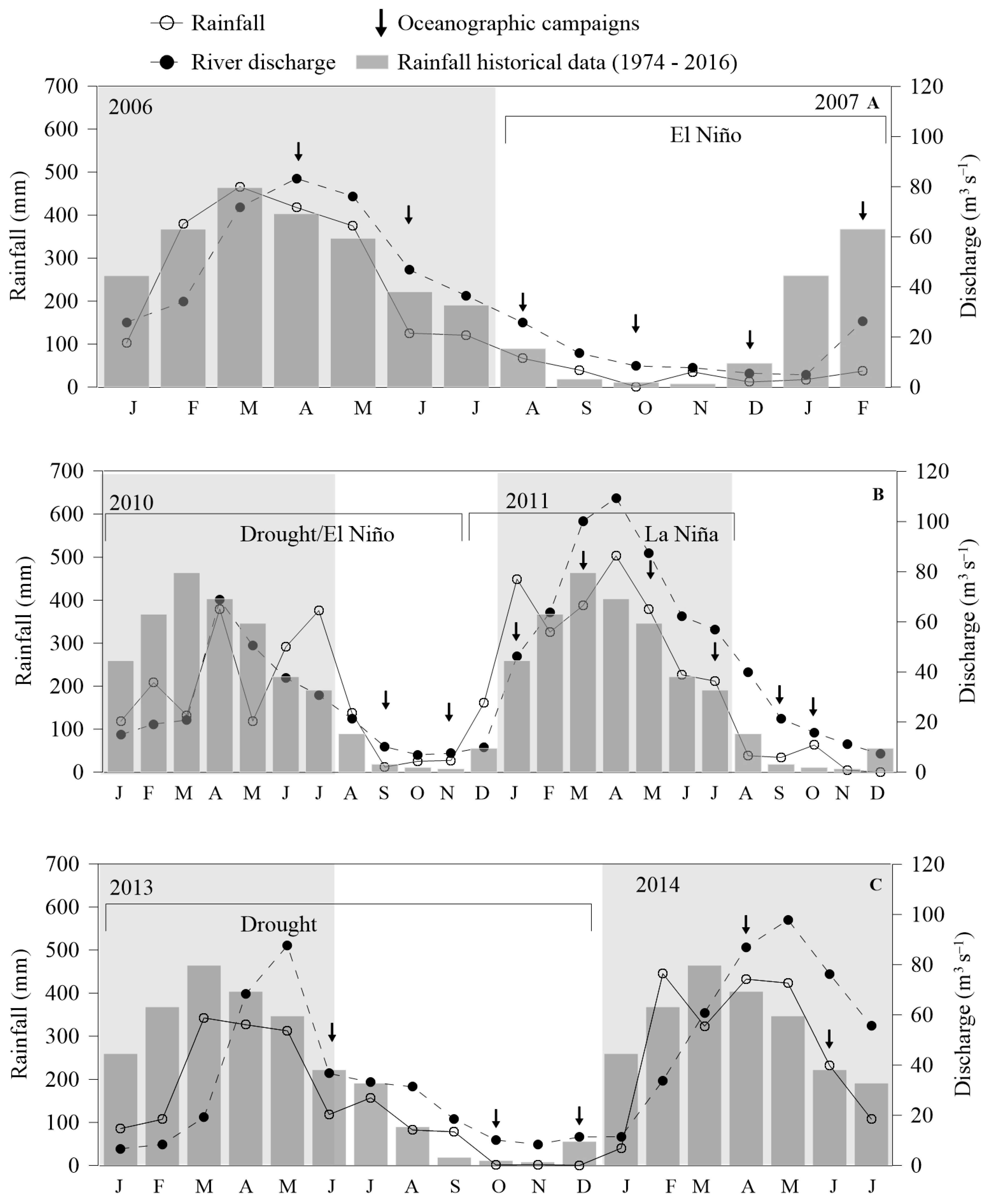
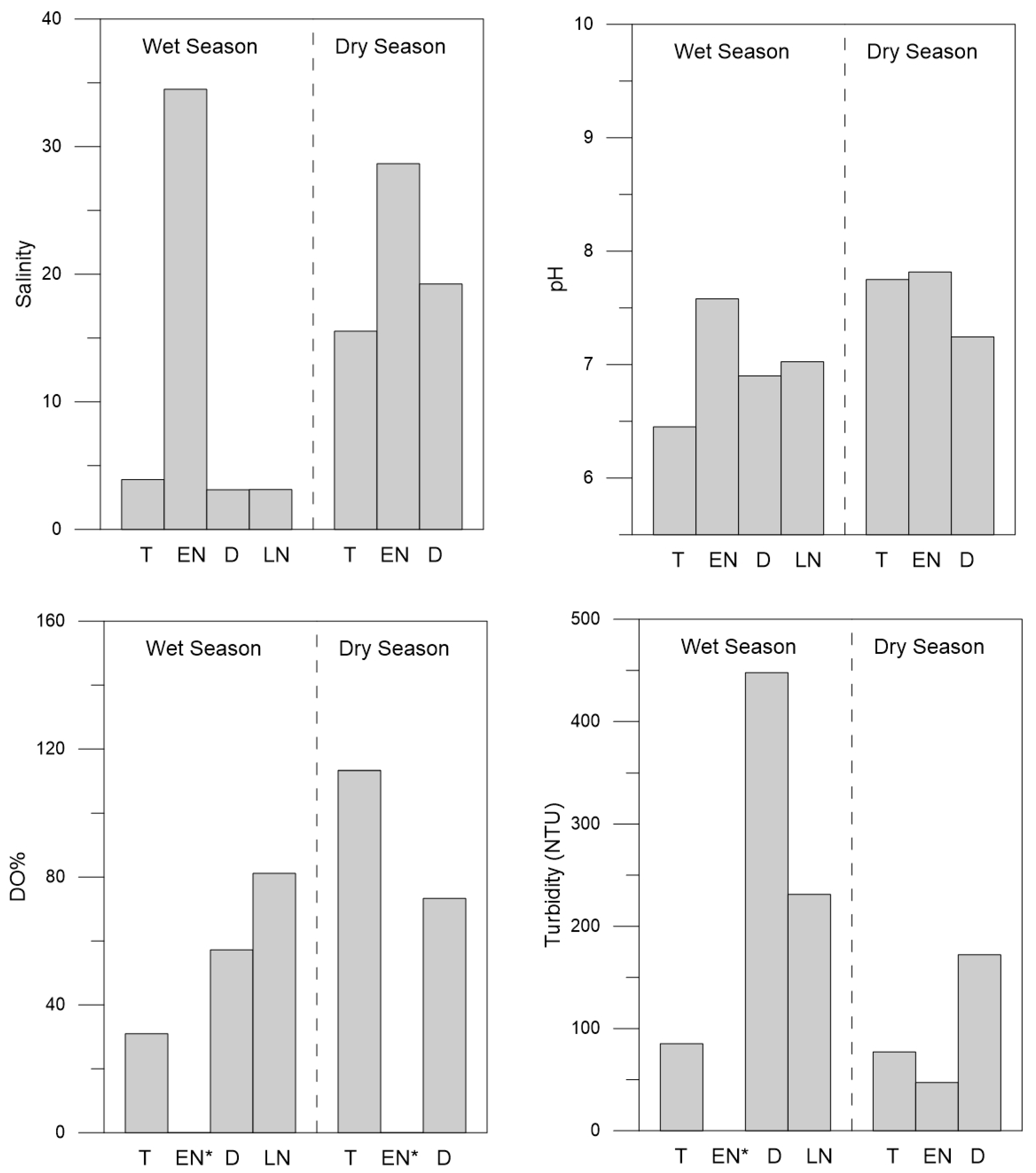
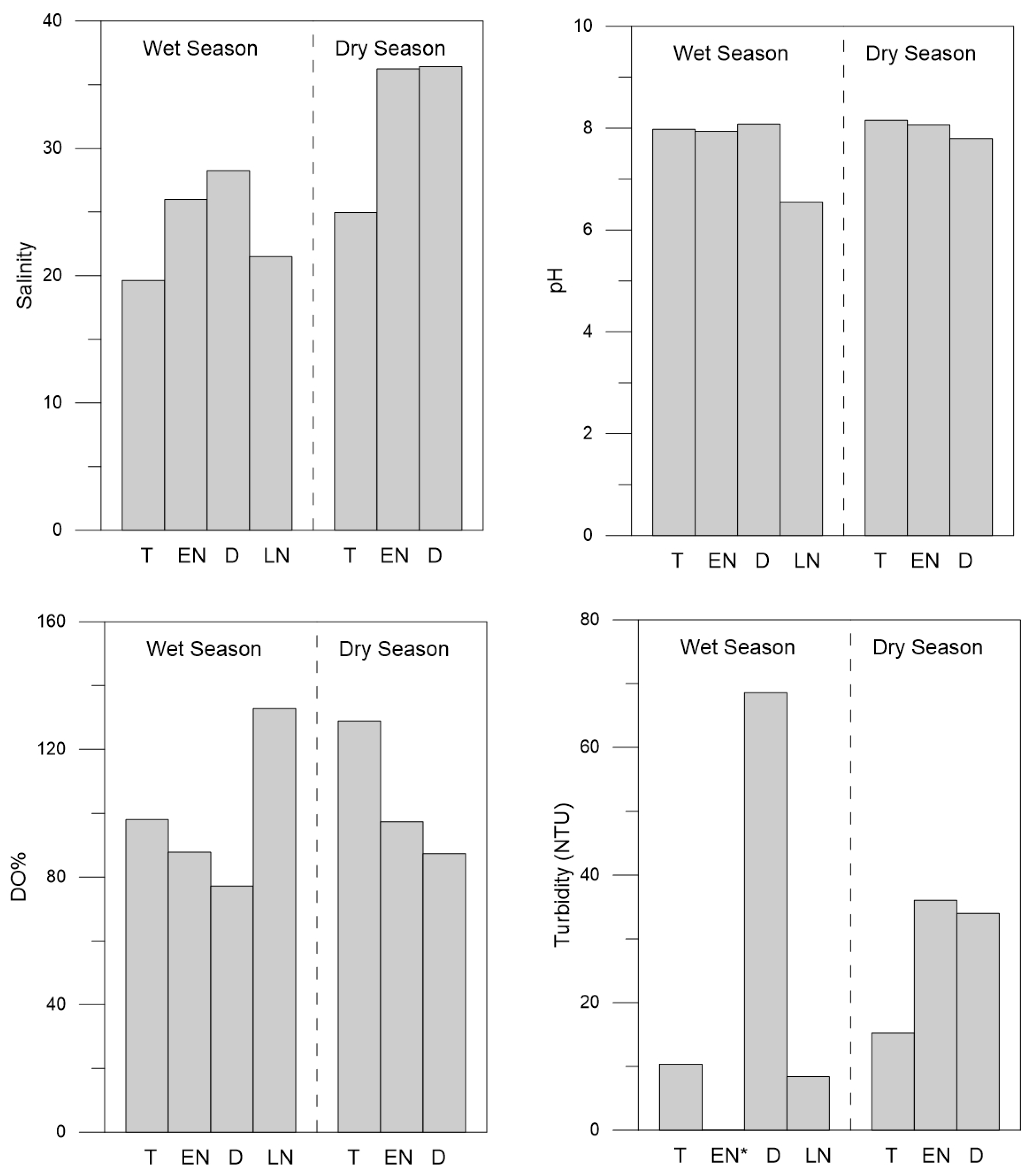
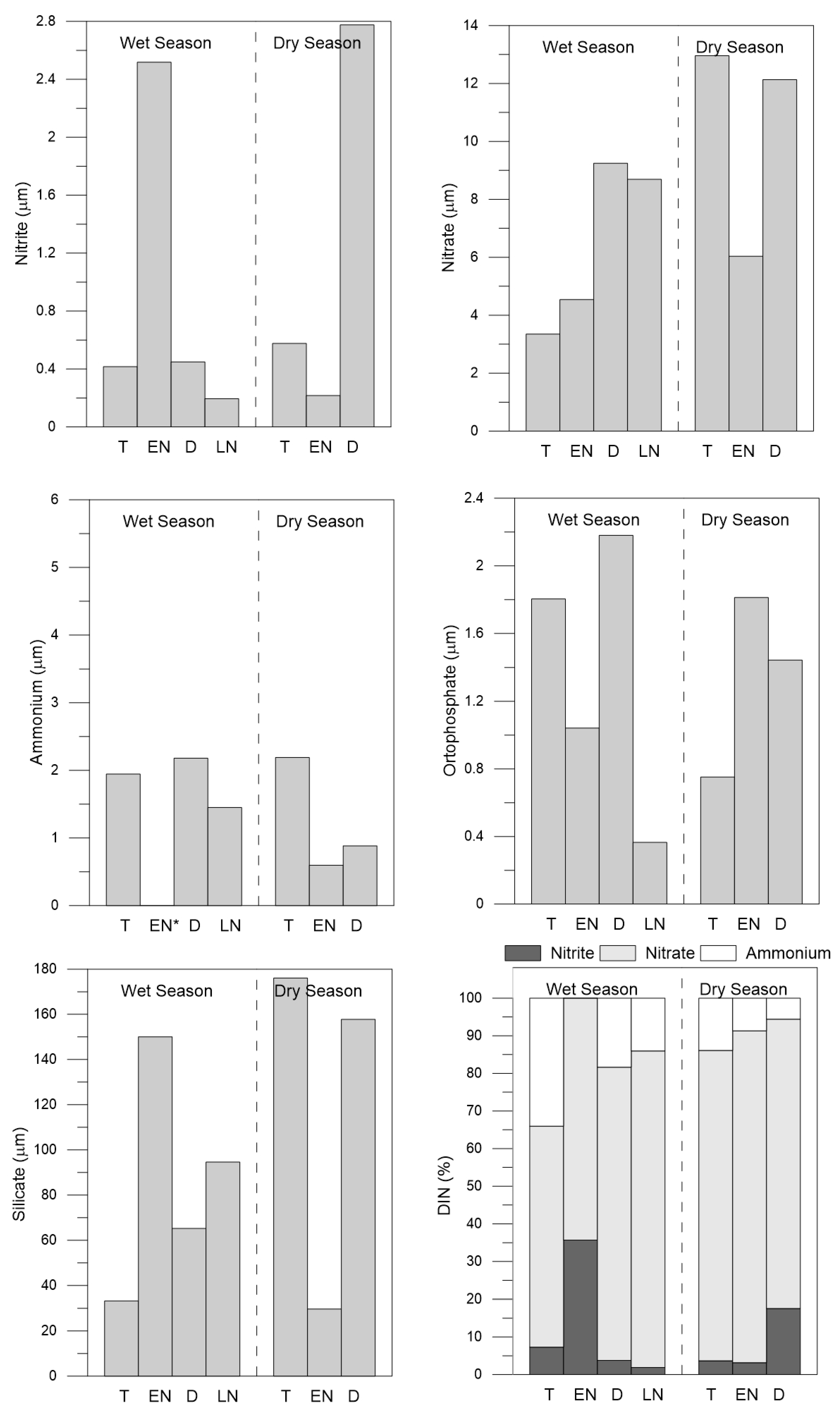



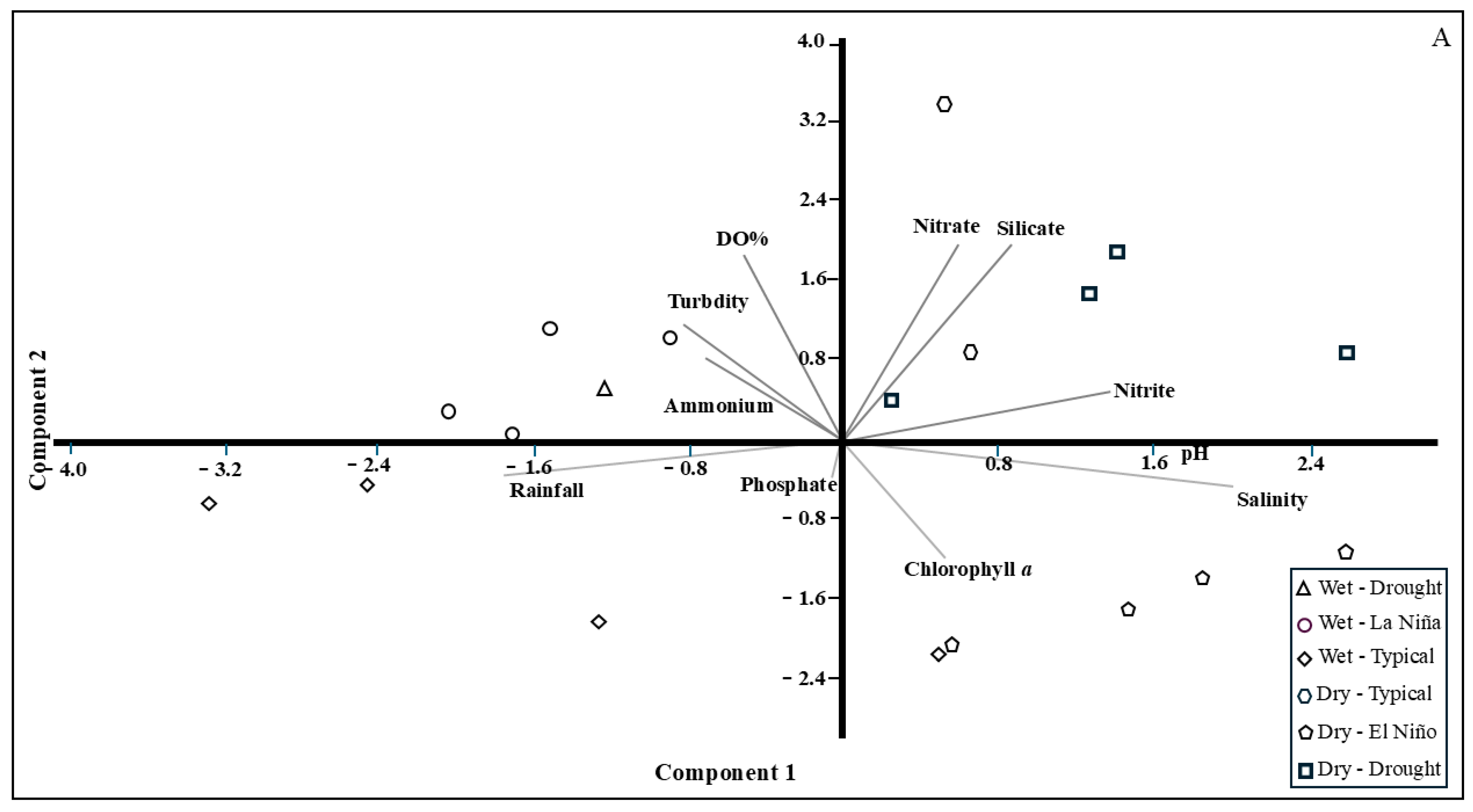

| Salinity | pH | DO% | Nitrite | Nitrate | Ammonium | Ortophosphate | Silicate | Chlorophyll-a | Turbidity | |
|---|---|---|---|---|---|---|---|---|---|---|
| Rainfall | −0.80 * | −0.58 * | 0.10 | −0.40 | −0.38 | 0.03 | −0.47 * | −0.42 | 0.13 | 0.00 |
| Salinity | - | 0.84 | −0.14 | 0.45 | 0.17 | −0.26 | 0.16 | 0.31 | 0.02 | −0.28 |
| Salinity | pH | DO% | Nitrite | Nitrate | Ammonium | Ortophosphate | Silicate | Chlorophyll-a | Turbidity | |
|---|---|---|---|---|---|---|---|---|---|---|
| Rainfall | −0.60 * | −0.40 | 0.35 | 0.61 * | 0.43 | −0.08 | −0.36 | 0.41 | 0.09 | −0.50 * |
| Salinity | - | 0.22 | −0.26 | −0.63 * | −0.57 * | −0.02 | 0.36 | −0.52 * | 0.24 | 0.40 |
Disclaimer/Publisher’s Note: The statements, opinions and data contained in all publications are solely those of the individual author(s) and contributor(s) and not of MDPI and/or the editor(s). MDPI and/or the editor(s) disclaim responsibility for any injury to people or property resulting from any ideas, methods, instructions or products referred to in the content. |
© 2024 by the authors. Licensee MDPI, Basel, Switzerland. This article is an open access article distributed under the terms and conditions of the Creative Commons Attribution (CC BY) license (https://creativecommons.org/licenses/by/4.0/).
Share and Cite
Monteiro, M.C.; Perreira, L.C.C.; da Costa, R.M. Effects of Climate Events on the Trophic Status of an Amazonian Estuary. Limnol. Rev. 2024, 24, 313-334. https://doi.org/10.3390/limnolrev24030019
Monteiro MC, Perreira LCC, da Costa RM. Effects of Climate Events on the Trophic Status of an Amazonian Estuary. Limnological Review. 2024; 24(3):313-334. https://doi.org/10.3390/limnolrev24030019
Chicago/Turabian StyleMonteiro, Marcela Cunha, Luci Cajueiro Carneiro Perreira, and Rauquírio Marinho da Costa. 2024. "Effects of Climate Events on the Trophic Status of an Amazonian Estuary" Limnological Review 24, no. 3: 313-334. https://doi.org/10.3390/limnolrev24030019
APA StyleMonteiro, M. C., Perreira, L. C. C., & da Costa, R. M. (2024). Effects of Climate Events on the Trophic Status of an Amazonian Estuary. Limnological Review, 24(3), 313-334. https://doi.org/10.3390/limnolrev24030019






